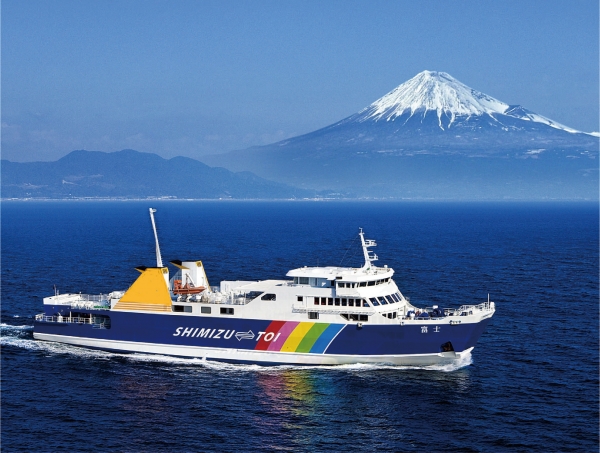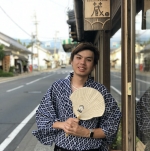Looping Suruga Bay: Admiring Japan’s deepest bay at the foot of Mount Fuji

Located in the heart of Shizuoka Prefecture (静岡県 Shizuoka-ken), Suruga Bay (駿河湾 Suruga-wan) is Japan’s deepest bay at 2,500m with a surface area of almost 2,500 km2 equivalent to almost 30% of Shizuoka Prefecture’s geographical area. While Suruga Bay is located much lower than Mount Fuji (富士山 Fuji-san), the two are linked by springs that bring down the precipitation from Mount Fuji via groundwater directly into Suruga Bay. This makes the water rich in nourishment and a fertile ground for fishing and catching its famed sakura ebi (桜海老 sakura shrimp). Beyond the plentiful tea-tourism destinations of Shizuoka, the surrounding areas of Suruga Bay host amazing natural sights of the bay together with Mount Fuji as well as abundant seafood and marine life.
Kick off your day at the Numazu Deep Sea Aquarium
It’s a fish! It’s a frog! No, it’s (*checks notes*) a… warty frogfish? (Image credit: ゆうき315 / CC BY-SA 4.0)
As Japan’s deepest bay, Suruga Bay actually hosts deep ocean water from three locations: the Kuroshio (黒潮), the Subarctic Zone, and the Pacific Ocean. The deep sea is one of those places we’ve generally heard of, but don’t know too much about. Here at Japan’s only aquarium dedicated to deep sea creatures, you can peel back a bit of that mysterious veil and discover wondrous creatures you can’t find at other aquariums in Japan and even the world.

This tiny little blob might look familiar to you as the inspiration for caricatures of octopi. (Image credit: National Marine Sanctuaries / CC BY 2.0)
Four meter long crabs, fishes with lights flashing out of their cheeks, and an octopus so cute it’s been given the name “adorabilis”. Numazu Deep Sea Aquarium (沼津港深海水族館 Numazu Minato Shin Kai Suizokukan) is one of the few places in the world where you can see the flapjack octopus, petite octopi with cute eyes that are typically extremely elusive living between 500–1,500m below sea level.

While you can keep a coelacanth in an aquarium in Animal Crossing: New Horizon, there are no living coelacanths in any aquarium in the world. (Image credit: Kentaro Ohno / CC BY 2.0)
Talking about elusive, the flagship exhibition at the aquarium is the Coelacanth Museum (シーラカンスミュージアム Shīrakansu Myūjiamu), the only place in the world where you can see a real frozen coelacanth specimen. Nicknamed the “living fossil”, coelacanths actually pre-date dinosaurs, with the oldest fossil from 410 million years ago. Once thought to have gone extinct 66 million years ago, they were rediscovered in the 1930s and are currently on the critically endangered list.
Numazu Deep Sea Aquarium (沼津港深海水族館)
Address: 83 Senbonminato-chō, Numazu, Shizuoka 410-0845
Nearest station: Numazu Station (沼津駅)
Access: 15-minute bus ride to Numazu Port (沼津港) bus stop
Opening hours: 10am–6pm
Admission fee: ¥1,600 (Adults), ¥800 (Elementary and high school students), ¥400 (4 years and below)
Tel: +81 55-954-0606
Crunch into some kari kari sakura ebi kakiage at Kurasawaya

The lightness of the batter, the sweetness of the sakura ebi, and the simple umami from sea salt sprinkled on top of the kakiage. (Image credit: Jeremy Jee)
Shizuoka Prefecture is Japan’s largest producer of sakura ebi, small pink translucent shrimp that measure 4–5cm in length. These shrimps are extremely hard to catch, living 200–300m underwater in the day, and rising to 20–30m at night. This means that fishermen have to catch them at night, and even so, only 2% of the shrimps remain alive when the fishermen return to land. Thus, sakura ebi is typically distributed around Japan in its dried form, making live sakura ebi hard to come by outside of the Kanto Region.

(Image credit: Jeremy Jee)
At Kurasawaya (くらさわや), you can enjoy sakura ebi two ways with the sakura ebi kamameshi set (桜海老釜めしセット sakura ebi kamameshi setto) for ¥2,255. Sakura ebi kamameshi (釜めし) is rice boiled with sakura ebi and cooked in a small traditional iron pot called a kama (釜), and the set comes with a sakura ebi kakiage (桜海老かき揚げ), a type of tempura (天ぷら) that is one of the most popular dishes in Suruga Bay with its bright yellow and pink colours and kari kari (カリカリ) crispiness. The restaurant is also located on a hill beside Suruga Bay, allowing you to look out the traditional shoji (障子) windows onto the bay as you enjoy your meal.
Kurasawaya (くらさわや)
Address: 69-1 Yuihigashikurasawa, Shimizu, Shizuoka, 421-3114
Nearest station: Yui Station (由比駅)
Access: 15-minute walk from the station or 5-minute drive from the station
Opening hours: 11am–3pm (Last order at 2pm), 5–8pm (Last order at 7pm, closed on Monday)
Tel: +81 54-375-2454
Admire views of Mount Fuji treasured through generations

The works by Hiroshige were so popular that he even influenced European artists like Van Gogh and Monet. (Image credit: Utagawa Hiroshige and Shizuoka Prefectural Tourist Association)
Located at the foot of Mount Fuji, you can probably catch a glimpse of it from anywhere around Suruga Bay. Of course, there are some spots that stand out from the rest, so here are three great spots to view Mount Fuji.
The first is a 3-hour round-trip hike from Okitsu Station (興津駅 Okitsu-eki) to Yui Station (由比駅 Yui-eki) through Satta Pass (さった峠 Satta-tōge), part of the old Tōkaidō (東海道 Eastern Sea Route) road that once connected Tokyo (東京都 Tōkyō-to) and Kyoto (京都市 Kyoto-shi) on a journey that took almost two weeks during the 17th century. This spot was of such scenic beauty that it was captured in a traditional ukiyo-e (浮世絵) woodblock painting during the Edo Period (江戸時代 Edo Jidai) by famous ukiyo-e artist Utagawa Hiroshige (歌川 広重) in his series, The Fifty-Three Stations of the Tōkaidō (東海道五十三次 Tōkaidō Gojūsan-tsugi). Reaching the viewpoint at the end, it’s quite interesting to see how little has changed in the almost 200 years since it was painted (well, apart from the highway that now runs through the area).
Satta Pass (さった峠)
Address: Yuinishikurasawa, Shimizu Ward, Shizuoka, 421-3115
Nearest stations: Okitsu Station (興津駅) / Yui Station (由比駅)

Another beloved spot, Hiroshige also made an ukiyo-e of Miho no Matsubara in The Fifty-Three Stations of the Tōkaidō. (Image credit: Utagawa Hiroshige and Shizuoka Prefectural Tourist Association)
The second spot is the Miho no Matsubara (三保の松原), a 7km long stretch of pine trees that line the seashore against the backdrop of Mount Fuji. Even though they are located far from each other, these pine groves are a UNESCO World Heritage Site as part of the Fujisan Cultural Site due to their cultural significance to the area. It was selected as Japan’s first site of scenic beauty back in 1922 and is also the setting for Hagoromo (羽衣 The Feather Mantle), one of Japan’s most performed noh (能 nō) plays. In it, a tennin (天人 celestial being) so overcome by the beauty of the area decides to stop by and take a bath in its waters. In order to do so, she leaves her magic feather mantle on a pine tree, which is later stolen by a fisherman who chances upon her. She eventually has to perform a part of a celestial dance for him to return her the mantle and upon its return, she disappears into the mist.
Miho no Matsubara (三保の松原)
Address: Miho, Shimizu-ku, Shizuoka, 424-0901
Nearest station: Shimizu Station (清水駅)
Access: 15-minute drive or 45-minute bus ride from the station

Don’t miss out on the cafe on the second floor where you can get some seasonal sweets as you admire the view. (Image credit: Shizuoka Prefectural Tourist Association)
The third spot is at the Nihondaira Yume Terrace (日本平夢テラス Nihondaira Yume Terasu). It is located on the Nihondaira (日本平) plateau, a National Place of Scenic Beauty of Japan that was once selected as the best plateau in the 100 best tourist spots in Japan. Opened in 2018, the Nihondaira Yume Terrace was designed by prolific architect Kuma Kengo (隈 研吾), who has designed numerous buildings worldwide including the Japan National Stadium. It has a 200m wooden observation deck and is headlined by an octagonal observation tower. The tower’s architecture is inspired by the Yumedono (夢殿 Hall of Dreams) inside the Horyu-ji (法隆寺) Temple in Nara (奈良市 Nara-shi), the ancient capital, and features intricate woodwork made from timber sourced from Shizuoka. The top floor provides an unobstructed 360º-view of Mount Fuji, Suruga Bay, and Shizuoka city.
Nihondaira Yume Terrace (日本平夢テラス)
Address: 600-1 Kusanagi, Shimizu-ku, Shizuoka, 424-0886
Nearest station: Higashi-Shizuoka Station (東静岡駅)
Access: 15-minute drive or 25-minute bus ride from the station
Opening hours: 24 hours (Observation Deck), 9am–5pm (Sunday-Friday, Observation Tower), 9am–9pm (Saturday, Observation Tower)
Admission fee: Free
Tel: +81 54-340-1172
Catching the twilight over Mount Fuji or soaking in an onsen

The evening view from Nihondaira Yume Terrace is extraordinary. (Image credit: Shizuoka Prefectural Tourist Association)
Stay at Nihondaira Yume Terrace to enjoy the twilight over Mount Fuji before catching a ferry from Shimizu (清水町 Shimizu-chō) to Toi (土肥), where you can relax in an onsen (温泉) to soak your woes away and finish up your loop around Suruga Bay.
From one of a kind exhibits at the Numazu Deep Sea Aquarium to storied views of Mount Fuji that have been treasured through the generations, Suruga Bay offers you a different perspective of Mount Fuji, As many locals in Japan say, Mount Fuji is best viewed from afar rather than by climbing it. And of course, don’t miss out on that delectable sakura ebi kakiage.
Header image credit: Shizuoka Prefectural Tourist Association





